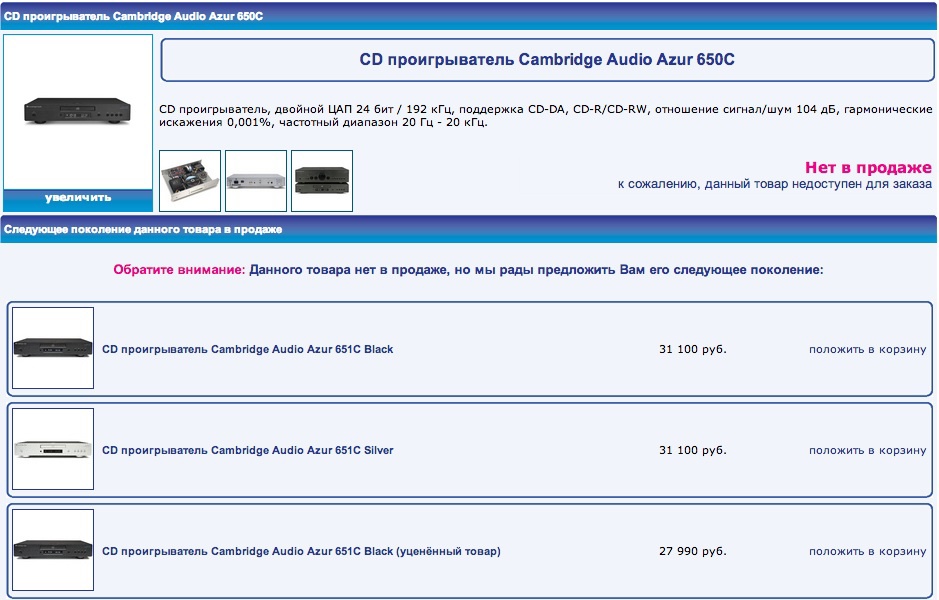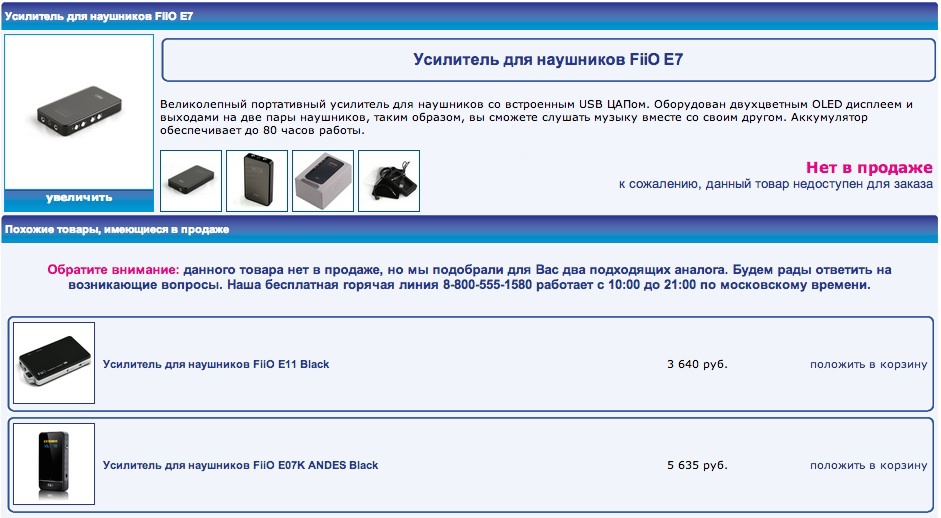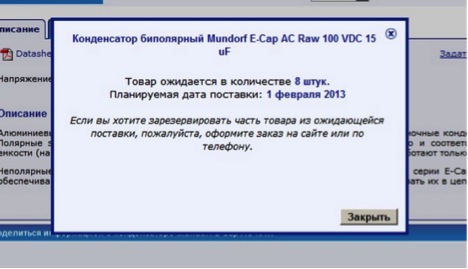How to improve the quality of customer service if the required goods are not in stock
 A rare online store has never encountered the problem of the lack of goods in stock. The impact of this problem extends far beyond the loss of sales of a single product. Because of this, customer satisfaction with the purchase decision may decrease, and in the future this may lead to the buyer choosing another store or brand. So, how can you still solve the problem of the lack of goods in stock, which online stores face today? We decided to look into this issue using the example of Audiomania’s experience.
A rare online store has never encountered the problem of the lack of goods in stock. The impact of this problem extends far beyond the loss of sales of a single product. Because of this, customer satisfaction with the purchase decision may decrease, and in the future this may lead to the buyer choosing another store or brand. So, how can you still solve the problem of the lack of goods in stock, which online stores face today? We decided to look into this issue using the example of Audiomania’s experience. First of all, it is worth noting that there are very few companies in the Russian Internet market that write about the presence / absence of goods in stock. Therefore, the conversion can be increased by simply indicating whether the product is currently available. Of course, there are situations when the goods required by the buyer end up in several stores at the same time (this happens especially often if several stores purchase goods from one supplier). In this case, the buyer, having got to the site where there is no information about the absence of the required goods in the warehouse, is likely to try to buy it (and increase the conversion even if the goods in the warehouse are really finished), but the value of the conversion obtained in this way will be small: for all the attractiveness store indicators in Yandex.Metrica or Google Analytics, real sales from such "purchases" does not happen. Therefore, honesty in this case is really the best policy.
In addition to a clear fixation of the absence / availability of goods (it is important, by the way, that the user saw this information before placing the order), you can take a number of proactive steps that will help keep the customer. First of all, alternatives should be offered. According to the experience of Audiomania, depending on the situation, replacement goods should be recommended in different ways.
')
Option 1:
If the product is out of production and is no longer delivered to stores, you need to honestly tell about it. If the manufacturer has replaced the outdated model with a newer one, it is logical to immediately offer it for replacement (provided that it is the same manufacturer, the same type of product and the price for the new model differs slightly from the old one). At the same time, our experience suggests that customers are satisfied with such an offer - a user who has come for an outdated model receives an updated version for practically the same money - which, naturally, does not give the slightest reason for doubt.

To replace the outdated Cambridge Audio CD player, we offer a new generation of products from the same manufacturer.
Option 2:
Sometimes (in the case of audio equipment, this takes place) the manufacturer replaces the outdated model with a new one so that the end user doesn’t see changes at first glance (for example, the model gets an alphanumeric name, slightly different from the name of the predecessor device, but from the point of view of consumer qualities practically does not change) - in such cases, we immediately redirect the user to a page with a new model. We use the same approach if the company for one reason or another changes its name, which also happens in the world of audio. At the same time, the user sees that he was redirected from the page of the desired product but new (usually for the “transition period” in brackets to the updated product name, we add the old designation).
Option 3:
It also happens that in the product line of the brand there is no clear product-follower of the discontinued model. At the same time, there is also a product of the same brand, similar in functionality and price to the desired, but coming out in a different line, and alternative products from other manufacturers. In this case, priority in the demonstration of alternatives must, of course, be given to the desired brand.

The closest analogues of the required amplifier are the products of the same manufacturing company
Option 4:
If there is no obvious replacement of a missing product within one brand, it is necessary to offer alternative products of the same category, but from other manufacturers. The price may vary within ± 10% of the price of the desired product. We recommend that you always offer the user not only goods at a reasonable price, but the goods are a bit more expensive than what you are looking for - usually the price is not the main criterion when searching for a product (the main thing for the buyer is not so much the cost of the goods as the ability to solve the task before him) option gives a good opportunity to make upsale. This option is the easiest, and we recommend using it when there is no opportunity to give the user any more personalized recommendations.
Option 5:
If for one reason or another your online store has ceased to cooperate with any brand, it is better to also tell the user about it. And offer products of another brand, which can be a worthy alternative to the desired. In this case, the more targeted the recommendation, the higher its effectiveness will be. In Audiomania, we compose individual texts for each missing item (we follow this very carefully when updating the product line).
Another possibility to keep the customer is to place on the page a missing (temporarily) product form, filling in which the user can receive by mail notifications in case of goods in stock. This tool can be very useful, but you need to be careful with it. First and foremost, carefully monitor which pages fit the form - if the goods are discontinued and never go to the store (in this case it is much better to pay attention to paragraph 1 and paragraph 5 of the list above), similar information on his page will be at least useless (and in the worst case, may cause frustration to the buyer, who will waste time waiting for the letter). A subscription is especially useful if the company has a small warehouse, and the range is significant. In such a situation, the likelihood that at some point the user does not have the goods in the warehouse increases, and at the same time the value of the subscription to the customer increases.
In Audiomania, we closely monitor the supply of each product and try to give buyers as much information as possible about the expected supply. Thus, when the user enters the product page, which is not currently available, but delivery is planned in the near future, he sees information about how many days the product will arrive.

The user knows when the nearest delivery of goods is expected.
In addition, knowing exactly when the goods will come, we suggest the user to make a preliminary order (this is especially true for products that are very popular). After pre-ordering the goods upon arrival at the warehouse is put "in reserve", and a letter is sent to the user that a reserved purchase is waiting for him, which turns out to be the case if the user, for example, cannot buy the goods right away (went on vacation or just busy) - so the product is guaranteed to wait for him, even if it is a superpopular model. In addition, this approach allows you to keep the buyer much more reliable than a subscription to the mailing list. This policy is great for companies that own large warehouse space and know exactly when they will receive one or another product.

The ability to pre-order is available along with information on the nearest supply
So, in short, the list of our tips for working with products that are not currently available is as follows:
- Always give the user maximum information about the product before he puts it in the basket. Be sure to give the user information in cases where: the product is not in stock; product / brand name has changed; the brand has withdrawn from the desired model; you stopped working with the brand.
- Always offer an alternative. Priority in the issuance of alternative options to give the goods the desired brand.
- Strive to ensure that the price of an alternative product is different from the desired one within ± 10%. Be sure to offer a more expensive product: not always the price for the customer is the decisive factor in the purchase.
- Use subscription forms so that the user can receive an alert in the event of receipt of goods at the warehouse. Do not put such forms on the pages of goods, the supply of which stopped and will not resume. Prefer alerts by mail if your store has a large assortment and warehouse space is modest.
- Offer customers pre-order goods, if you know exactly when it goes to the warehouse. This is especially true for companies with large warehouses and a clear delivery schedule.
Source: https://habr.com/ru/post/223721/
All Articles